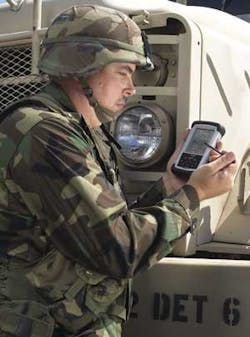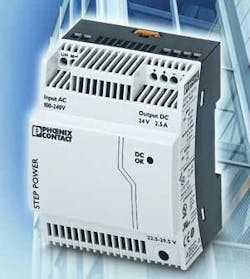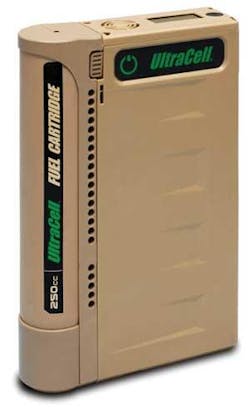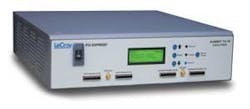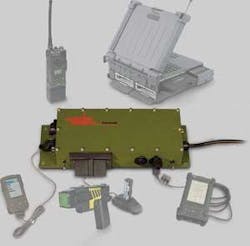Technology firms continue to meet the evolving power needs of warfighters on the digital battlefield.
By Courtney E. Howard
Advanced electronics are increasingly finding their way onto today’s digital battlefield. These electronic devices, as well as their associated power systems, carry a great many requirements not only to survive the rigors of combat, but also to meet the needs of warfighters. Technology firms in the mil-aero industry are diligently working to put ever-greater power—portable, efficient, safe, rugged, and reliable power—in hands of soldiers.
Shrinking SWaP
Soldiers are carrying significantly more weight—much of which consists of advanced electronics and the power supplies that fuel them—than in years past. Combat vehicles are increasingly packed with a widening selection of electronics, delivering a combination of command-and-control, mission-rehearsal, and intelligence, surveillance, and reconnaissance capabilities.
The size and weight of military electronics, whether soldier-borne or vehicle-mounted, are shrinking out of necessity. Current and future electronics systems must be designed with reduced size, weight, and power (SWaP) attributes, to deliver as much functionality as possible in as small and light a form factor as is realistic. The shrinking electronics form factor can have a tremendous effect on systems and subsystems, and therefore on the professionals designing them.
“Size and weight are critical for the manageability of the equipment,” says Ken O’Neill, director of high-reliability product marketing at Actel Corp. in Mountain View, Calif. “The need to minimize size and weight has an influence on downstream electronics: the lower the power consumed by the electronics, the smaller and lighter the power supply. Additionally, less power consumed means less heat emitted, again having system-level benefits by reducing or eliminating the need for forced cooling. This, in turn, improves reliability, and reduces the size and weight of the equipment.”
Reliability required
End users care about size, weight, and reliability, O’Neill says. In fact, the need for reliability oftentimes precludes the use of lead-free solders, components, and component finishes, despite directives that require their adoption (see “RoHS and RoHS-like legislation,” page 25).
“Our defense-oriented customers do not want RoHS [Restrictions on Hazardous Substances]-compliant products, especially those that are lead-free,” says Mike A. Innab, president of Martek Power Inc. in Torrance, Calif. “There is still a large concern about the reliability issues on the defense side with lead-free components and solder.”
Many contractors and programs have not qualified lead-free solder, and do not intend to use lead-free solder for many years to come, O’Neill reports. “Availability of non-RoHS parts is a concern, and it’s an area where companies can add value; we are committed to continue to supply traditional leaded solders as long as there is demand.”
Innab takes the same tack. “High-reliability products are critical to military end users, and reliability and longevity are expected by default,” he explains. “Longevity is something that we at Martek Power Abbott are proud of. Not only do we produce our products for the life of the program, but we have been using our standard off-the-shelf products to provide solutions for our customers who have experienced obsolescence issues with other vendors.”
Power infrastructure
The reliability of power electronics is critical to warfighters in the field. It can mean the difference between mission success and failure, or even life and death. The same can be said of various other federal entities, including the Federal Aviation Administration (FAA) in Washington.
“The financial consequences of an outage somewhere in the FAA network—not to mention the disruption of business and personal travel—can be severe,” says Mark A. Ascolese, chairman and chief executive officer of EDSA Micro Corp. in San Diego. “The direct and indirect financial toll can quickly reach millions of dollars in higher fuel expenses, lost landing revenue, increased employee costs, and spoiled perishable cargo...not to mention the disruption of airline schedules, passengers’ missed business meetings, canceled vacations, and so on.”
Not surprisingly, FAA officials research and employ advanced technologies with which to protect their agency’s electrical power infrastructure. Out of a commitment to passenger safety and convenience, officials at the FAA have adopted software from EDSA at its mission-critical facilities. EDSA is contracted to deploy its Paladin Live platform, a power analytics electrical power infrastructure protection system, at major air-traffic control facilities across the United States.
Paladin Live is being deployed in two types of critical national air space (NAS) facilities: air route traffic control centers (ARTCCs) and terminal radar approach control (TRACON) facilities. One ARTCC or TRACON facility, responsible for traffic between airports in a specific geographical area, can service as many as 60 airports and manage more than 500,000 square miles of airspace. Each locale has significant electrical power requirements, for computing, communications, navigation, air-traffic control, weather, and other capabilities.
“FAA facilities are comparable to some of the most demanding mission-critical data centers in the world,” Ascolese says. “But when you take a data center and then add air traffic displays, communications, and weather-tracking equipment, you end up with something far more complex than you’ll usually find at a server farm.”
This contract award is intended to increase air safety by alleviating potential electrical power problems in ARTCC or TRACON facilities, which are responsible for controlling 17 million square miles of America’s airspace, says an EDSA representative. “As the FAA operates 24 hours a day, seven days a week, 365 days a year, and moves more than 760 million passengers and 40 billion tons of freight a year through its airspace, the agency must have a reliable power system.” Paladin Live will aid FAA personnel in predicting potential power problems, and possibly averting an outage and disruption to flight operations or traveler safety.
Added functionality
Innovative systems designers and systems integrators are marrying size reductions with increased functionality, packing more electronics in the same or less space. Personnel at International Rectifier in El Segundo, Calif., as an example, are designing space-saving solutions and then filling the free space with added capabilities.
Cost, functionality, and efficiency are also key characteristics of military electronics and the devices that power them, although the ranking may be different for different programs, admits Tiva Bussarakons, marketing director for International Rectifier’s aerospace and defense DC-DC products. “We are attempting to add more functionality to our products under development. This is being accomplished by integrating control circuitries to minimize size, therefore vacating space in a package for added functional circuitries.”
Actel engineers also are dedicated to incorporating more in a small power-electronics form factor, and potentially replacing several devices with one solution. The company’s mixed-signal Fusion Programmable System Chip (PSC) incorporates analog functions, embedded flash, and field-programmable gate array (FPGA) fabric in one chip, while also reducing the parts count by 25 percent and board area by roughly 33 percent.
Actel’s mixed-signal Fusion PSC family provides an alternative to several discrete devices, at a time when designers are searching for system- and power-management solutions that minimize system cost and complexity, while improving power efficiency and reliability, O’Neill explains. Actel customers include designers seeking to replace costly and complex multi-chip approaches to power management, such as multi-voltage FPGA devices, with a one-chip solution.
Fusion has been employed in a system that supports Modular Management Controller (MMC) hardware platform management functionality on an Advanced Mezzanine Card (AMC) form-factor module delivering encrypted software-defined radio functionality. “The mixed-signal FPGA capabilities of Actel’s Fusion device enabled our customer to reduce its total BOM [bill of materials] parts count, by integrating the functions previously performed by discrete analog and digital devices; and, Actel’s design flow and DirectCore IP [intellectual property] enabled them to concentrate their efforts on finalizing their complex SDR/crypto payload.”
Fusion can be driven from one 3.3-volt supply, eliminates the need for special power-up sequencers, and can monitor and sequence a multi-voltage system for voltage and current. Fusion, well suited to system- and board-management applications, offers single-voltage operation, power-management capabilities, and built-in temperature control. It also supports on-chip (internal diode) and remote temperature-monitoring capabilities; can employ external temperature sensor inputs to control heating or cooling system elements; and can flag a warning, turn on a fan, or shut down a system when temperature or power meet or exceed programmable thresholds. For many end users, particularly warfighters in the field, this safety net is invaluable.
Complexity conundrum
In many cases, upgrades and added capabilities increase the size of electronics systems and the devices that drive them. “As electronic systems become ever more complex, so do their power supplies,” O’Neill admits. Providing a wider range of voltage levels, improved noise immunity, and EMI protection all tend to make power supplies larger and heavier, he explains.
“Each advance in semiconductor process technology creates challenges for the manufacturers of power-supply components,” O’Neill continues. “Today’s FPGAs, for example, require at least two operating voltages—one for the logic core and at least one for the I/O [input/output]. If several I/O standards are being used, then many supply voltages will be required.”
As a consequence, power-component manufacturers have to keep pace by offering LDO regulators, DC-DC converters, and more with several output voltages, O’Neill says. Further, as manufacturing processes shrink, so do supply voltages and their tolerances. “A 0.13-micron semiconductor device may have only plus-or-minus 75-millivolt tolerance on its core power supply. In hostile radiation environments, where single-event transients in the power-supply components can sometimes exceed 75 millivolts, designers are faced with having to make careful power-supply component choices.”
A great level of integration is needed, as well as intelligent management of complex power systems, O’Neill advises. Designers are encouraged to consider products, such as Actel’s Fusion, that combine programmable digital logic with analog current, voltage, and temperature monitoring, and provide a means of digitally managing complex power systems.
Portable power
Soldiers deployed in the field require power solutions that offer the utmost in portability, offering small size and light weight. “The important characteristics of portable batteries are weight and size, especially as mission durations are increasing,” notes Jeff VanZwol, marketing director of Micro Power Electronics in Beaverton, Ore.
The mission demand for wearable power per soldier averages 1 watt per hour, or 24 watts per day, according to VanZwol. A one-day mission, then, requires up to 10 pounds of battery weight, which typically comprises an assortment of alkaline and lithium batteries. Mission durations often range from between 8 and 12 hours to several days, subsequently doubling or tripling the weight of batteries carried by the soldier.
In general, most of the handheld or wearable devices used by soldiers use lithium or alkaline batteries with high energy density. High-power lithium cells, using either Lithium Iron Phosphate (LiFePO4 or Olivine) or Lithium Manganese Oxide (LiMn2O4 or Spinel) formulations, are commercially available battery technologies, says VanZwol. “These batteries are capable of delivering 50 to 100 amps of current for sustained periods, and they enable lithium batteries to better support applications that demand high currents.”
This summer, however, an increasing market shortage of lithium-ion batteries affected end users worldwide, including warfighters in the field. Lithium-ion batteries are used to power a multitude of portable electronics, such as military radios, laptops, cellular devices, meters, power tools, and audio/visual equipment.
Panasonic executives in Rolling Meadows, Ill., responded to this adverse market situation, offering nickel metal hydride (NiMH) batteries as a short-term, reliable product replacement solution. “These batteries were developed to meet the requirement for increasingly high energy levels, up to 1.2 nominal voltages,” says a representative. “When applications demand a small size and high-energy levels, Panasonic NiMH batteries are a choice for battery requirements.”
Demand for density
Regardless of the physical makeup of the batteries, soldiers simply need more power without being weighed down by more or larger equipment. Land-based warriors want batteries that offer double the capacity in the same form factor, VanZwol explains. “Unfortunately, capacity gains offered by battery vendors are about 10 percent per year, so there is a technological supply/demand gap.” It is a gap that many believe traditional batteries can no longer fill.
“Longer mission and run-time requirements have outstripped the capacity gains offered by battery vendors,” VanZwol admits. “Will we see a handheld radio being powered by an integrated fuel cell in the next fuel years? Not likely, but fuel cells may find a natural resting place as part of a portable charging station that can charge batteries in the field, offering soldiers extended mission times.”
Fuel cells will make gains in mechanical/electrical/chemical performance and enter the tactical arena, where they will complement battery solutions already in operation, VanZwol predicts. It is a future that many in the portable power supply field envision, in fact.
Fuel cells for the future
Matt Westra, a product manager at UltraCell Corp., a producer of reformed methanol fuel cells (RMFCs) in Livermore, Calif., is among those working toward the goal of seeing fuel cells deployed on the battlefield. Yet, Westra and his cohorts in the power industry face some challenges.
“The remote nature of missions determines much of the type of products that can be deployed, and since most of those items have to be carried into these areas, size and weight play a major role,” Westra says. “Once in those remote locations, a customer wants to know that the power product they are using is reliable for the duration of the mission.”
Mission duration seems a moving target, however. Missions are growing longer and, as a result, require power electronics that are able to sustain themselves for at least 72 hours, Westra estimates. “The power electronics on the market need to address this need, and still be lightweight and reliable, but also be able to convert power for different power devices,” he says. “Today, batteries are being used to fill the need, but they are not optimal. The current power solutions are large and heavy for what they give the soldier. The basic need is for a smaller, lighter-weight solution that provides the same amount of runtime or more.”
Advancements in technology have not carried over into power-source development, Westra admits. Current electronics are a fraction of the size they were 10 to 15 years ago, yet they demand more power to run. It is a challenge that the power industry across the board is investigating, and working to solve, he says.
Battery chemistries—such as Li-Air, Li-CFX, Stirling Engines, and fuel cells—have the potential of increased capacity per weight and size, offers Westra. UltraCell’s fuel cell technology delivers a power capacity-to-weight ratio in the 500 watt-hour-per-kilogram (Wh/Kg) range, but “the ability to increase this range is there.”
UltraCell engineers designed the company’s extended run-time, fuel cell solutions to be lightweight, rugged, night-vision compatible, approved for military use, and able to power electronics for extended periods of time in remote locations. The UltraCell XX25-based micro fuel cell platform, with hybrid battery and extended runtime fuel options, won the “Best Soldier System Innovation & Technology” award at the Soldier Technology U.S. 2008 Conference.
“This award helps to promote fuel cells as a viable alternative, and underscores the company’s success in developing a longer-lasting, lightweight power solution for military applications,” says Frank Beafore, vice president of UltraCell’s Ohio operations. The UltraCell solution was selected as the product displaying the most innovation, technological advancement, and capability to contribute to the modernization of the soldier.
“UltraCell is at the forefront of fuel cell technology with the first fuel cell to reach CERDEC’s Technology Readiness Level (TRL) 7, the first to pass MIL-STD 810F Environmental Tests,” says Westra. He and his team at UltraCell continue to advance the technology, with help from the U.S. Army Communications-Electronics Research, Development, and Engineering Center (CERDEC) Army Power Division and the Defense Advanced Research Projects Agency (DARPA). CERDEC and DARPA together funded and awarded a follow-on contract to UltraCell to enable the further development and field testing of the 25-watt UltraCell XX25 RMFC.
Vehicle and portable
Combat vehicles on the battlefield are delivering much-needed power to warfighters, thanks to power converters.
U.S. Army personnel have adopted in their Bradley Fighting Vehicles a ruggedized, lightweight power converter, the Multi-Mode from ITT Corp. in Fort Lauderdale, Fla. The vetronics device provides soldiers convenient access to usable electrical power, on the order of 12 volts DC and 110 volts AC, to operate items such as spotlights, laptop computers, cell phones, and small power tools.
ITT also offers a remote outlet model of the Multi-Mode, which weighs less than 10 pounds and is cooled with natural convection, for vehicles with limited space. With this version, outlet connections can be remotely mounted to any convenient location inside the vehicle. The power-conversion portion of the device can be mounted anywhere else on the vehicle, and then connected to the outlet part via easy connect/disconnect cables.
Similarly, the Power Accessory Distribution System (PADS) from Curtiss-Wright Controls Embedded Computing in Littleton, Mass., is a rugged, drop-in power source that delivers 110VAC, 12VDC, and 5VDC power outlets in 28VDC power-based military vehicles.
“The PADS product line allows our number-one customer, the U.S. soldier, to conveniently keep all critical electronic equipment charged and operational while out on extended missions,” says Mark Baker, vice president and general manager at Curtiss-Wright Controls, Littleton Operations.
Soldiers can use PADS to power various electronic devices that would otherwise not be supported by their vehicle’s traditional 28VDC power supply. The accessory power system is designed to provide power conditioning and power outlets—including dual 12V “cigarette” receptacles, dual 110VAC utility outlets, dual 5V USB ports, and an 18–30V input connector—for 110/12/5-volt plug items without compromising the vehicle equipment. Further, the PADS system is compact, rugged, modular, and well suited for harsh environments and for operation in the -30°C to +55°C temperature range.
Engineers at Altair Nanotechnologies Inc. in Reno, Nev., also set on developing a revolutionary battery able to withstand temperature extremes. The provider of advanced nanomaterials technology used in power and energy systems won a $350,000 contract through the U.S. Army’s Picatinny Arsenal in New Jersey to deliver prototype batteries for the Army’s M119, a 105-millimeter lightweight gun digitization program.
Altairnano’s lithium-titanate batteries boast rapid-charging capabilities, long life, and the ability to operate in temperatures ranging from extreme cold to searing heat, such as the deserts of Iraq and mountains of Afghanistan. Testing of the company’s prototype batteries, roughly the size of a motorcycle battery, is expected to extend into early 2009. Altairnano’s lithium-titanate batteries are also being considered for similar military applications by the U.S. Army and U.S. Marine Corps.
“This is another important milestone in our battery development,” Terry M. Copeland, Altairnano’s chief executive officer, says. “The current program is only a beginning. Once the technology is proven in the field, we expect interest and supply contracts from other U.S. and foreign military services.”
Future empowerment
Power electronics, like the systems they fuel, will continue to evolve to meet the growing needs of warfighters in the increasingly digital battlefield. Few of us have any idea what the future may hold when it comes to military skirmishes; and yet, the future of power electronics for defense is certain. “The push for smaller, lighter, more efficient, and lower cost is expected to continue,” Martek Power’s Innab says. “Unless there are drastic changes in the requirements by mil-aero customers,” UltraCell’s Westra adds, “companies that manufacture power electronics will continue to provide products that are lighter in weight and can power at a higher range.”
Interesting reading
More information is available in the following white papers:
“Impact of SprayCool Cooling Technology Applied to Power Electronics on Shipboard Cooling System Infrastructure,” by SprayCool at www.spraycool.com.
“Extending the Life of Wireless Sensor Networks Using the Smart NanoBattery,” from Micro Power at www.micro-power.com.
RoHS and RoHS-like legislation
The Restriction on Hazardous Substances (RoHS) Directive 2002/95/EC of the European Parliament and of the Council prohibits the sale of new electronic equipment containing substances considered to be hazardous, including lead, cadmium, mercury, hexavalent chromium, polybrominated biphenyls, and polybrominated diphenylethers in the European Union.
RoHS-like, environmental legislation with regard to producing and recycling electronics is a global trend. U.S. states with regulations modeled after the EU RoHS directive in action or pending adoption include: California, Colorado, Connecticut, Florida, Hawaii, Illinois, Indiana, Louisiana, Massachusetts, Michigan, Minnesota, Montana, North Carolina, Nebraska, New Hampshire, New Jersey, New Mexico, Nevada, New York, Ohio, Oregon, Rhode Island, South Carolina, Tennessee, Texas, Virginia, Vermont, Washington, and Wisconsin.
Japan’s Green Procurement Practices, referred to as JPSSI, is said to be more restrictive than RoHS, and Korea, China, Canada, Taiwan, and Australia have similar legislation in effect or pending.
For more, read “The cost of compliance: A RoHS retrospective,” Military & Aerospace Electronics, August 2007, and online at www.milaero.com.
Power-distribution panels destined for war zones
Fidelity Technologies Corp. in Reading, Pa., is manufacturing an advanced type of circuit protection to be used by the U.S. Army in battlefield environments.
Fidelity engineers, under a U.S. Army contract valued at up to $124 million over the next five years, will develop the Power Distribution Illumination System, Electrical (PDISE). The PDISE is designed to control the amount of power flowing from generators such that it meets the standard electrical requirements of soldiers’ fielded equipment.
“In the field, the military requires massive generators, which power lights, computers, radios, and other electrical sources,” J. David Gulati, president of Fidelity, explains. “We are building the power-distribution systems to control and limit the amount of amps being run, making it possible for soldiers to safely operate electrical devices in the field.”
As part of the contract, Fidelity engineers will construct four PDISE units with various amps. Multiple units—each of which will reduce the amperage—will be interconnected and extend from the powerful generator. The final box will reduce power to the point that it can safely flow into the military’s standard-class “L” military outlets, says a representative.
The PDISE power-distribution system ensures warfighters can access reliable electricity in virtually any part of the world. The system is designed to be portable and easily assembled and dismantled as necessary.
For more information, visit Fidelity Technologies Corp. online at www.fidelitytech.com.
Mission-critical power on the International Space Station
The National Aeronautics and Space Administration’s (NASA’s) International Space Station, which launched aboard the space shuttle Discovery on May 31, 2008, boasts an on-board Automated External Defibrillator (AED) powered by a custom lithium battery pack from Micro Power in Beaverton, Ore.
Engineers at Micro Power—a company that supplies military OEMs with battery and charger solutions to power mission-critical equipment such as AEDs—customized the battery pack to comply with space flight requirements. NASA officials rigorously tested and approved the battery packs to ensure they would perform to space flight specifications for batteries, explains a representative.
“Of course, it is our hope that the defibrillator is never used during any space station mission, but should a cardiac-arrest emergency arise, the Micro Power battery pack is designed to power up safely the first time, and to provide enough power to save a life in this unique, on-board environment,” says Jeff VanZwol, marketing manager at Micro Power.
For more information, visit Micro Power online at www.micro-power.com.

